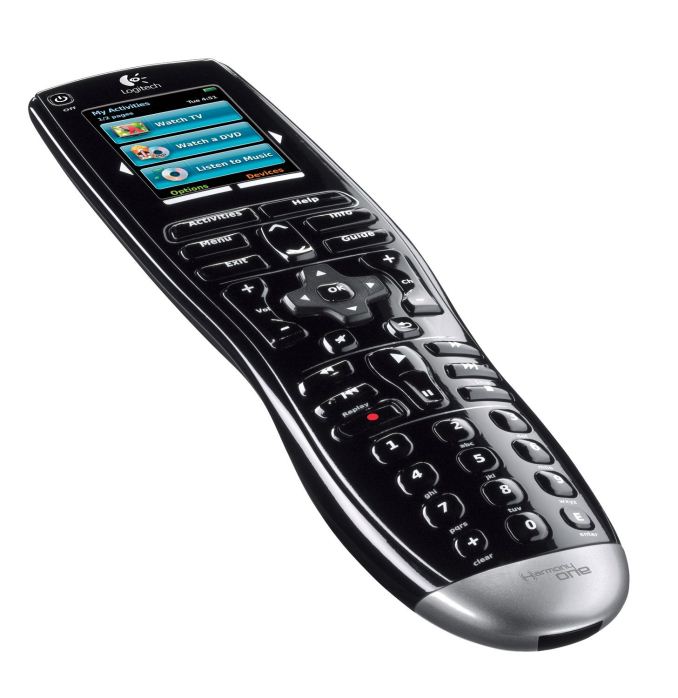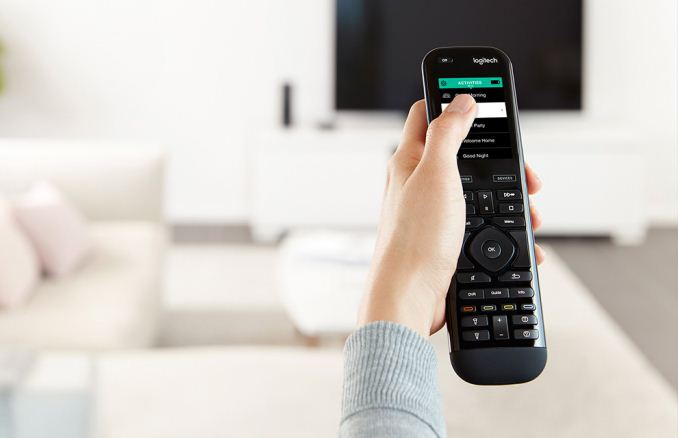The Logitech Harmony Elite Experience: Ultimate Control
by Brett Howse on February 14, 2017 8:00 AM EST- Posted in
- Accessories
- Logitech
- Remote Control
- IoT
- Smart Home
- Harmony

Perhaps I’m dating myself, but the television in my house when I was young required the viewer to get up and change channels manually. Although it wasn’t very convenient, there were only two channels, and the satisfying ker-chunk of the switch almost made it worth it. We’ve come a long way since then, and now the ubiquitous remote control seems like it’s just part of normal life. But just because something has become normal, doesn’t mean it can’t be improved.
Harmony remotes have been improving on the standard universal remote control for over a decade, and Logitech purchased the founding company back in 2004. There have been quite a few iterations on the Harmony remote, and the Logitech Harmony Elite is the current top of the line model from Logitech, incorporating the Elite remote, the Harmony Hub, and the Harmony app, into one complete solution for not only remote control, but also home automation.
My previous remote - the Logitech Harmony One
I’ve been a Harmony user for over ten years now, starting with a Harmony 880, then the Harmony One, and now the Harmony Elite. The latest model improves on its predecessors in several ways, but keeps the original brilliance of the Harmony series with a single, easy to set up, and powerful solution to replace the myriad of remotes for all of the devices in your home.
| Logitech Harmony Products | |||||
| Product | Harmony 350 | Harmony 650 | Harmony 950 | Harmony Companion | Harmony Elite |
| Maxium Devices | 8 | 8 | 15 | 8 | 15 |
| Display | None | Color | Color Touch | None | Color Multi-Touch |
| Control Type | IR | IR | IR | IR/RF/Bluetooth/IP | IR/RF/Bluetooth/IP |
| Batteries | 2 AA | 2 AA | Rechargable | CR2302 | Rechargable |
| Comes with Hub | No | No | No | Yes | Yes |
| Channel Favorites | 5 | 23 | 50 | 50 | 50 |
| Price | $35 | $50 | $200 | $150 | $300 |
Logitech created the Harmony Hub a few years back, and was their first play into the game of home automation. The Harmony Hub is the key to the Harmony Elite’s ease of use, and powerful integration with the home. Whereas the remote allows control over IR only, the Hub gets connected to the home network, allowing it to control devices through IP, and it also supports Bluetooth control. This widely expands to capabilities of the remote, from just controlling A/V equipment, to now allowing control of smart home devices like the Nest thermostat, Phillips Hue, Lutron lighting, Sonos, and more. Adding the capabilities of IP control also make the experience no longer require line of sight, and the control is more reliable than IR alone.
But the key to the overall ease of use with Harmony continues to be its unique activity-based control. For those that haven’t used it, I’ll give a quick overview of the concept.
Activities
The original genius with Harmony, especially compared to other Universal remote controls, was that Harmony groups devices into activities. The typical setup would be one remote per device, so if you want to watch a movie, you may need a remote to power on the television and choose the correct input, a remote for the A/V Receiver to select the input and control the audio, and a third remote for the disc player. Then, if you wanted to watch television, you’d turn off the disc player, switch the inputs on the TV and Receiver, and then pick up the cable box remote to change channels. This is somewhat of a worst-case scenario of course. Perhaps the television remote will also control the DVD player or cable box in some manner, but regardless this is how most people operate an entertainment setup. Even the best universal remote control is always some sort of compromise, since inevitably there will be some function you need to perform on a device that will require you to dig out the remote for it.
Harmony dispenses with this silliness. By grouping devices into activities, the remote will perform every function required automatically, and it will then control the correct devices for that activity. For instance, when you decide you want to watch a movie, you can select the activity titled “Watch a Movie” on the remote. It will then power on the correct equipment, select the correct inputs, and automatically switch the remote functions to support the activity. Play/Pause and the like will be mapped to the disc player, and volume control will be for the A/V Receiver. You can customize each activity to suit your individual tastes, and every single button can be mapped to other functions if you need to change any of the functions. Then, when you want to watch television instead, pressing “Watch TV” will power off the disc player, power on the cable box, select the correct inputs, and remap the remote buttons as required.
For any of those rare times where you need to control some obscure feature of your equipment, Harmony also has a Devices mode, where you can pick a single device and get full control of it and all of its features.
The combination of activities and devices make the cumbersome process of controlling several devices into a simple, seamless task. The Harmony Elite builds on this already powerful control that Harmony has always had, but the underlying philosophies are the same.












99 Comments
View All Comments
mjeffer - Tuesday, February 14, 2017 - link
I've had a phone or two that had integrated IR blasters. While they work, most of the apps for them were clunky at best and tactile buttons are just so much better when you want to quickly grab the remote and change the channel or volume.SpartanJet - Tuesday, February 14, 2017 - link
I bought the Elite and love it, though if I had to do it again I'd opt for the hub and cheap remote option as I use the iphone app almost 100% of the time. Though if I was an ADroid user (like the remote tablet that came with my TV) I'd have stuck with Elite as the ADroid Harmony app constantly crashes or loses connection with the hub...ADroid being ADroid I guess.mjeffer - Tuesday, February 14, 2017 - link
"Perhaps I’m dating myself, but the television in my house when I was young required the viewer to get up and change channels manually."As a kid, I remember we had a VCR with this fancy new "remote". It was attached to the VCR with a long cord that plugged into the front of it that you had to drag across the room and risk tripping anyone who wanted to walk by.
Makaveli - Tuesday, February 14, 2017 - link
As a current Harmony One user I like the upgrades however the price is a non starter. For an upgrade from a perfectly working remote its just too much. I would consider it at $199.CalifLove00 - Tuesday, February 14, 2017 - link
This is a great product. I will say like most here, the cost the item is high when you think of it as just a remote. That said, this is an item that likely gets used every single day. IF you find it useful, it is likely because it is saving you from having to use multiple remotes EVERY day. When put in perspective, the benefit outweighs the cost. Should it be cheaper - yes, even $200 is fair. BUT, given it proves it's usefulness more than any other competing product (IMHO) at the end of the day, it's worth every penny.ALL that said, I would like to see Logitech offer better batteries. For whatever reason, EVERY single Harmony device I've had has had its battery die extremely early in the product life. While my elite bat has not died out right, it's life has fallen way off, The thing cannot stay off the charger longer than a days use without needing to be recharged.
Houdani - Tuesday, February 14, 2017 - link
I have an Ultimate, and agree that placing the buttons north of the screen was a rubbish decision. In order to counteract their awkward placement, I opted to reprogram the channel up/down buttons to behave as skip forward/back buttons instead. From a usability standpoint I think this is better overall. I would do the same thing with an Elite.As a side benefit, this remapping of the buttons counts as a page up/down when browsing the channel listing.
As for the number buttons; I imagine folks mainly use them to type in their favorite stations. As an alternate, they can simply populate their screen with direct links to all of their favorite stations (including the logo for each station). Works great.
melgross - Tuesday, February 14, 2017 - link
I've got several issues with this review, but I just want to mention an error here.The Harmony does not have a knowledge of state. What it has is a knowledge of whatever setting it has made. There really isn't any feedback to the unit as to real time state. That's why, if you make a manual change to any basic setting also available on the Harmony, it isn't aware of it.
A knowledge of state is when a device is updated as to the state of the devices it's being used with, regardless of whether the device has been used to change those settings. The Harmony has none of that knowledge, and it does lead to problems.
I've tried a number of their devices over the years, and I stopped using all of them after a short period of time. A problem is that the limitations on Harmony devices can exceed its usefulness. Any adjustments to the system often require a manufacturers remote to accomplish. As the remote has no idea of what you're doing, you need to reprogram it for these changes.
When someone sits down and grabs a different remote, which you can't always remove because there is some function or other the Harmony doesn't do properly, or at all, everything is thrown out of wack. The problem is that not every family member is going to understand how these remotes work, and will prefer to grasp the tv control instead. The works with kids, and even my wife.
Another problem comes when you have several ways to do basically the same thing. You need to make multiple set-ups for that which becomes clumsy, particularly since the screen doesn't allow good descriptions of functions. have three different ways to watch a movie? Three ways to watch Tv shows, music? That's a problem.
Yes, it can be done, but most people will find it a hair pulling problem. I'm not happy about it myself.
Makaveli - Tuesday, February 14, 2017 - link
Some good points there.The easiest fix for the wife and kids is to hide those old remotes so everyone is forced to use the harmony. This way no can change state because there are no remotes to do so. My girlfriend is pretty bad with technology and doing this forced her to learn to use the Harmony and now she is fine with it.
melgross - Tuesday, February 14, 2017 - link
Sure, until they go and push a button on an a/v device, and leave it that way.Makaveli - Thursday, February 16, 2017 - link
Time to invest in locked cabinets :)